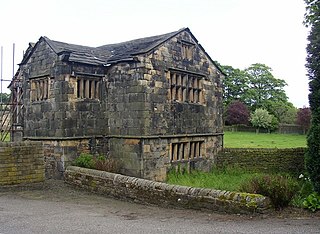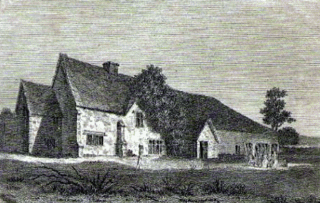Related Research Articles
Sopwell Priory was a Benedictine nunnery founded around 1140 on the site of an ancient hermitage in Sopwell, Hertfordshire, England. After the Dissolution, the priory was torn down and a Tudor manor house constructed in its place.

Arthington Priory was an English monastery which was home to a community of nuns in Arthington, West Yorkshire, founded in the mid-12th century. The priory land is occupied by a residence called "Arthington Hall", which was built around 1585, and little, if anything, remains of the priory. The site of the priory church is possibly now occupied by a farmhouse called The Nunnery. The community was the only one of nuns of the Cluniac congregation in Yorkshire and one of two in England. It was established through a grant by Peter de Arthington.

St James’ Church lies in Warter, an estate village in England, in the Yorkshire Wolds, part of the East Riding of Yorkshire.

Nunkeeling Priory was a priory of Benedictine nuns in the East Riding of Yorkshire, England founded by Agnes de Arches or de Catfoss in 1152. It was dedicated to St. Mary Magdalene and to St. Helen. The priory became well known and nearby Keeling was renamed Nunkeeling. The priory suffered from great poverty towards the end of the 13th century. In the early 14th century several cases of disobedience among the nuns became known, leading to disciplinary measures ordered by the archbishop of York.

Swine Priory was a priory in the village of Swine in the East Riding of Yorkshire, England. The site of the Cistercian nunnery is a Scheduled Monument.
Wilberfoss Priory was a priory in the East Riding of Yorkshire, England.
Heynings Priory was a priory in Knaith, Lincolnshire, England.
Legbourne Priory was a priory in the village of Legbourne, Lincolnshire, England.

Nuncotham Priory was a priory of Cistercian nuns in Brocklesby, Lincolnshire, England.
Orford Priory was a priory of Premonstratensian canonesses in Stainton le Vale, Lincolnshire, England, and one of nine within the historical county.
Stixwould Priory was a priory in Lincolnshire, England, a Cistercian nunnery founded by Lucy, countess of Chester, in 1135. The Mappa Mundi describes it as Gilbertine, but modern authors regard it as Premonstratensian. Originally suppressed in 1536, Benedictine nuns from Stainfield were then moved in by the King. In 1537 the nunnery was refounded for Premonstratensian canonesses, before being finally suppressed in 1539. It was one of nine such houses within the historical county.

Ellerton Priory was a priory of Cistercian nuns in Swaledale in North Yorkshire, England. Its ruins lie in the civil parish of Ellerton Abbey.

Marrick Priory was a Benedictine nunnery in Richmondshire, North Yorkshire, England, established between 1140 and 1160 by Roger de Aske. The parish Church of the Virgin Mary and St. Andrew and 400 acres of local land also belonged to the priory, which thrived until the 16th century, in spite of the depredations of marauding Scots.

Rosedale Priory was a priory in Rosedale Abbey, North Yorkshire, England that was founded c. 1150–1199. By the time the priory was suppressed in 1535, it had one prioress and eight nuns. The religious house in Rosedale was a priory and not an abbey, despite the village being given the name Rosedale Abbey, and it is unclear why this came about.
Yedingham Priory was a Benedictine priory in North Yorkshire, England dedicated to the Blessed Virgin Mary. It was home to Benedictine nuns from 1163 to 1539.

Kirklees Priory was a Cistercian nunnery whose site is in the present-day Kirklees Park, Clifton near Brighouse, Calderdale, West Yorkshire, England. It was originally in the ancient ecclesiastical parish of Dewsbury. The priory dedicated to the Virgin Mary and St James was founded by Reiner le Fleming, Lord of the manor of Wath upon Dearne, in 1155 during the reign of Henry II.
Syningthwaite Priory was a priory in West Yorkshire, England. Syningthwaite is the site of the Cistercian convent of St Mary, founded c. 1150–1160 by Bertram Haget and suppressed in 1535, having been heavily in debt in the early 16th century. At the Dissolution the priory housed nine nuns, the prioress, eight servants and other labourers. The priory site is enclosed by a moat and includes a Chapel Garth.

St Mary's Priory was a Benedictine priory of nuns at Kington St Michael in Wiltshire, England. Founded before 1155, the priory was dissolved in 1536.

The Keldholme Priory election dispute occurred in Yorkshire, England, in 1308. After a series of resignations by its prioresses, the establishment was in a state of turmoil, and the Archbishop of York, William Greenfield, appointed one of the nuns to lead the house. His candidate, Emma de Ebor', was deemed unacceptable by many nuns, who undermined her from the start to the extent that she resigned three months later. The archbishop, forced to find another candidate, claimed that he was unable to do so from within the priory and appointed Joan de Pykering from nearby Rosedale Priory. It is likely that Keldholme saw de Pykering as an intruder, and it seems to have reacted against her in much the same way as to her predecessor.
References
- ↑ Page, William, ed. (1974). "Houses of Benedictine nuns: Priory of Nunburnholme". A History of the County of York. Vol. 3. Institute of Historical Research. Retrieved 18 February 2013.
- ↑ Yorkshire CXCIV.NW (includes: Hayton; Londesborough; Nunburnholme; Warter.) (Map). 1:10560. Ordnance Survey. 1953.
- ↑ Historic England. "Site of Nunburnholme Priory (1011897)". National Heritage List for England . Retrieved 9 February 2019.
53°55′34″N0°42′04″W / 53.9260°N 0.7012°W